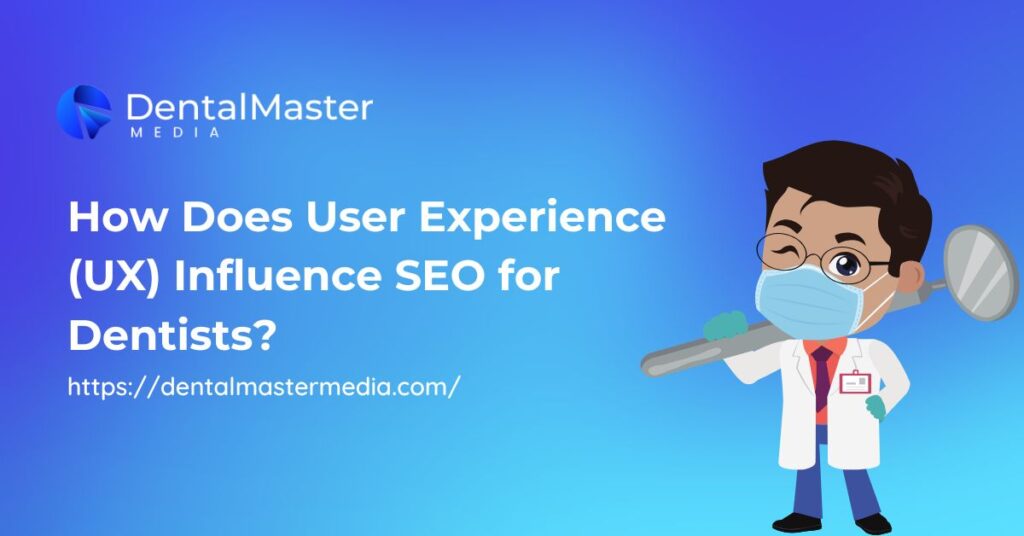User Experience, or UX, is about how easy and pleasant it is for someone to use a website.
It includes things like how fast the site loads, how simple it is to find information, and how well the layout works on phones or tablets. When people visit a dental website, they expect it to be smooth, fast, and helpful.
SEO, or Search Engine Optimization, is the process of making a website show up higher on search engines like Google. The goal is to appear at the top when someone searches for a dentist or dental service.
Good SEO attracts visitors, but good UX keeps them on the site and encourages them to take action—like booking an appointment.
When UX and SEO work together, the website becomes more useful for both patients and search engines. That’s why a strong UX isn’t just nice to have—it plays a big role in making SEO more effective.
How UX Helps Search Engines Understand Your Dental Website
What Google Looks for in a Dental Website
Google uses many signals to decide which websites to show first in search results. Some of the most important are directly related to UX.
One major factor is page loading speed. If your dental site loads slowly, visitors may leave before they even see your content, and Google will see that as a negative sign.
Another key element is mobile-friendliness. Today, most people search using their phones. If your site doesn’t work well on a small screen, it won’t rank as high.
Google also checks how well your content is structured. This includes using headings, short paragraphs, and simple words to help visitors understand your services quickly.
In addition to these technical elements, Local SEO for Dentists plays a major role in how search engines rank your site for nearby searches.
A good user experience—combined with accurate business information, clear service pages, and consistent contact details—helps boost your local visibility and reach more potential patients in your area.
Why a Good Layout Matters
A clear, well-organised layout helps people find what they need without confusion. For example, if someone visits your homepage looking for teeth whitening options, they should be able to locate that section right away. If the layout is messy or confusing, they’ll likely leave.
Good layout encourages visitors to stay longer and view more pages. This tells search engines that your site is helpful.
The longer someone stays, the more likely they are to trust your clinic and take the next step—like calling or booking.
The Impact of UX on Patient Behaviour
Bounce Rate and Time on Site
Bounce rate refers to the number of people who visit your website and then leave without clicking on anything. A high bounce rate usually means the visitor didn’t find what they were looking for.
For instance, if someone searches for “teeth cleaning near me,” clicks your website, and then leaves within seconds, that tells Google your site might not be meeting their needs.
On the other hand, if people stick around, read your services, check out your team, or look at testimonials, that tells Google your content is useful.
This improves your SEO over time because search engines want to show the most helpful websites.
How Design Builds Trust
A professional and clean design can make a huge difference in how patients feel about your clinic.
When your website looks modern, with readable fonts, real images of your team or office, and clear contact info, it builds trust.
In contrast, using generic stock photos or cramming too much text on a page can make the site look unprofessional.
Visitors may wonder if they can trust your practice. Good design sends the message that your clinic is organised, caring, and ready to help.
Mobile UX Is Now More Important Than Ever
With more people searching on phones than on desktops, mobile UX has become critical. If your dental site isn’t mobile-friendly, you could lose half your potential patients before they even see your homepage.
Mobile UX means that your site looks good and works well on all screen sizes. Text should be easy to read, buttons should be easy to tap, and forms should work without pinching or zooming. Google prefers mobile-friendly sites and gives them better positions in search rankings.
Think about a person looking for an emergency dentist while out. If your site opens quickly, shows the right info, and has a working call button, you’ve likely gained a new patient.
Clear Calls to Action and Easy Booking Influence SEO
A call to action (CTA) is what tells visitors what to do next. For dentists, this usually means buttons like “Book Now,” “Call Us,” or “Schedule an Appointment.”
These need to be clear, visible, and working properly on both desktop and mobile.
If your booking form takes too long to load or is hard to use, people might give up. But if everything works smoothly, more people will complete the action.
This helps your SEO indirectly, because Google sees users are engaging with your site. That’s a sign of a helpful and high-quality website.
Page Speed: A Hidden SEO Power
Speed is one of the most overlooked parts of UX, but it plays a major role in SEO. A fast website keeps visitors happy.
A slow one drives them away. Every second counts. Studies have shown that even a one-second delay in page load can lead to a big drop in user satisfaction and conversions.
Slow speed is often caused by large image files, outdated plugins, or poor hosting services. Tools like Google PageSpeed Insights can help dentists check how fast their website is and offer suggestions for improvement.
Improving page speed not only enhances the user’s experience but also sends strong signals to search engines that your website is reliable.
It’s a crucial part of Optimising SEO for Dentists, helping your site rank better while also keeping potential patients engaged.

Local SEO and UX: A Winning Combo for Dental Clinics
Consistency in Contact Info and Location
For dental clinics, local SEO is a big deal. Most patients look for clinics near them. That’s why your contact details—like Name, Address, and Phone Number (NAP)—should be easy to find on every page.
Many dental websites also include a clickable map or a direction link, which helps users find the office fast.
This is where UX and SEO work hand in hand. If visitors can’t easily find your contact details, they may leave your site frustrated.
But when your info is clearly placed and easy to use, people are more likely to take action—and search engines notice.
Using Reviews and Testimonials Properly
Another part of local SEO is showing real feedback from patients. Displaying honest reviews or testimonials helps visitors feel more confident in your services.
People trust what others say, especially when it comes to health decisions.
Good UX makes sure these reviews are easy to read and find. When people take the time to read patient stories, they stay longer, click more, and are more likely to book a visit.
These actions all boost your site’s performance in search results.
How SEO For Dentist Is Boosted by UX Best Practices
A well-designed dental website supports both users and search engines. When your pages are organised, easy to read, and helpful, they perform better in search.
Keywords can only do so much—UX is what makes them work effectively.
For example, if a dentist offers multiple services, each one should have its own page. These pages should be simple to find, clearly written, and easy to browse.
That kind of structure supports SEO For Dentist strategies and helps each service rank on its own.
Strong UX also enhances Dental SEO by making it easier for search engines to understand your site’s layout and content relevance.
Good UX also improves internal linking, keeps people exploring the site, and encourages positive interactions—all things that support long-term SEO growth.
Conclusion
Strong UX makes a dental website easier to use, faster to load, and more enjoyable to explore. These improvements don’t just help visitors—they also send powerful signals to search engines.
When people stay longer, interact more, and feel confident in what they see, search engines recognise your website as helpful and trustworthy.
This leads to better rankings, more visibility, and ultimately, more patients.To make the most of your digital presence, it’s smart to invest in both SEO and UX together.
If you’re looking for expert help to take your dental website to the next level, the team at Dental Master Media offers support and strategies that truly make a difference.

Suraj Rana is the owner of Dental Master Media and a leading expert in SEO for dental practices. With a passion for dental marketing, he has successfully helped numerous dental clinics climb the search engine ranks. Suraj’s expertise makes him a go-to resource for effective, results-driven dental marketing.

